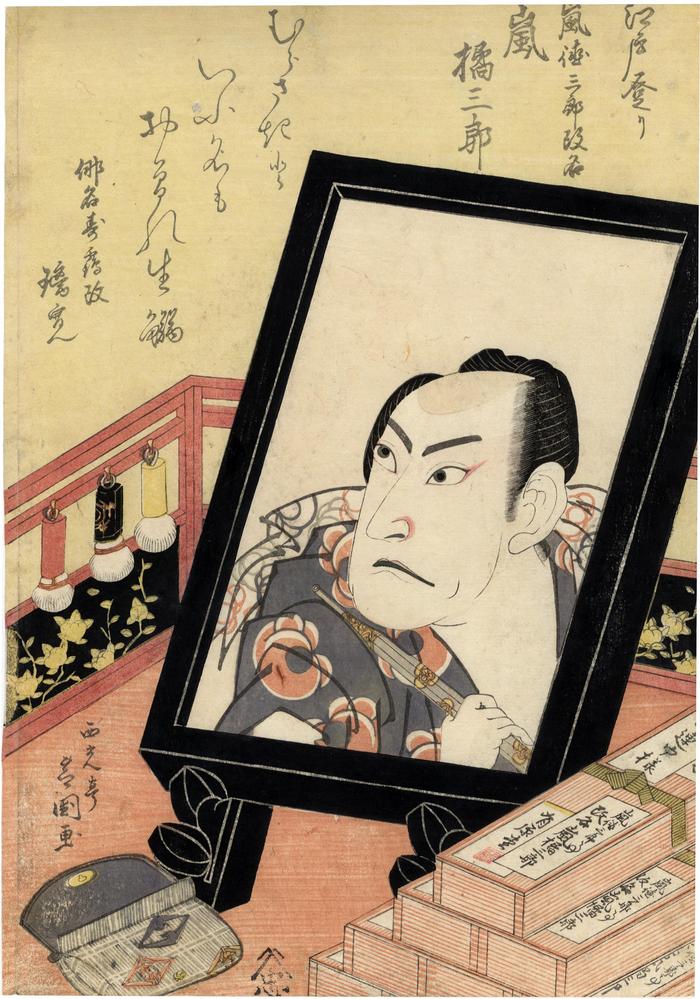Saikōtei Shibakuni (西光亭芝国) (artist )
Just arrived from Edo (江戸登り), Arashi Kitsusaburō II (嵐橘三郎), formerly named Arashi Tokusaburō (嵐徳三郎) - Edo nobori Arashi Tokusaburō gaimei Arashi Kitsusaburō
09/1822
10.5 in x 14.75 in (Overall dimensions) Japanese color woodblock print
Signed: Saikōtei Shibakuni ga
(西光亭芝國 画)
Publisher: Ariwaradō Chūbei (Mark 015 - seal 04-019)
Museum of Fine Arts, Boston
Waseda University
Royal Museums of Art and History, Belgium (via Cultural Japan) Osakaprints.com wrote: "Arashi Tokusaburô II (嵐徳三郎) backstage, preparing for his shûmei (name change) to Arashi Kitsusaburô II (嵐橘三郎) and for his performance of the play Yorimasa nue monogatari, Naka Theater, Osaka"
Later they added: "The deferential poem, composed by the actor, reads Murasaki tô fumei yu na mo ôsore nama-iwashi (Due to my inexperience, I must accept the name Uncooked Iwashi [Sardine] instead of Murasaki [Purple]: むらさきといふ名もおそれ生鰯). He signed it as Haimyô kotobuki tsuru [= Jukaku] aratame Rikan (A good-luck crane ― changing my poetry name to Rikan: 俳名寿鶴改璃寛). This follows Kitsusaburô I's example, who had used "Rikan" as his haimyô. In the eleventh month of 1828, Kitsusaburô II would also take his haimyô "Rikan" for his geimei (stage name). The mon (crest) of the Arashi lineage of actors ― a tachibana (mandarin orange blossom: 橘) ― is visible on Kitsusaburô's robe and on the lacquered balustrade just below his makeup brushes."
****
The text in the upper right clearly states that Arashi Tokusaburō (嵐徳三郎) has changed his name to Arashi Kitsusaburō (嵐橘三郎). The term 'kaimei' (改名) indicates the name change. These names also appear along with the name of the publisher of this print on the boxes in the lower right.
The poem on the left is by the actor himself signed with his haimyō or poetry name. As best we can tell it is a humble poem that plays off the of word play of the word 'murasaki' which generally means 'purple', but here might even refer to a sardine, a small fish, a small fry. And yet, the actor's robe is purple decorated with an orange blossom family crest. Even the black lacquer stand with the mirror showing the reflection of the actor has legs decorated with large orange blossom carvings.
There are three make-up brushes hanging on the left are worth looking at because the center brush, the one with the black lacquer handle, has the crest of Arashi Kitsusaburō I, Arashi Kitsusaburō II's predecessor. Therefore it was probably Kitsusaburō I's personal tool and forms a great link to his successor. Another interesting touch is the tobacco pouch near the left leg of the mirror. It is decorated with the tsurubishi (鶴菱) or flying cranes in a lozenge motif, the personal emblem of Nakamura Utaemon III, a rival of Kitsusaburō. Was it a gift to that actor on the event being recorded here? Or, was it left in the dressing room as a reminder of their rivalry? We will never know, but would hope it was a gift to honor his rival.
****
"The legend at the top states that the portrait is of the Edo actor Arashi Tokusaburō, now Arashi Kitsusaburō. The verses that follow are signed 'Rikan,' the literary name his predecessor had used. The name change and the name of the publisher with red seal appear on the script-scroll boxes at right. The orange-blossom motif, symbol of the actor, is worked into the lacquered gallery beneath the hanging make-up brushes and his pipe. Shibakuni designed a similar portrait of Kitsusaburō."
The example shown by Dean Schwaab in his Osaka Prints on page 95 has a blue ground and no publisher's seal.
****
There was a subgenre of Osaka prints that was popular in the 1820s showing actors backstage reflected in their own make-up mirrors. Two such prints are in the Lyon Collection and they include this one by Shibakuni and another one by Shunshi. We have added a third example by Yoshikuni from 1822. It can be seen by clicking on the jpeg below the featured item on this page.
****
Illustrated in:
1) Bosuton bijutsukan shozō Kamigata-e mokuroku, Kitagawa, Kansai daigaku, 2007, p. 92.
2) Schätze der Kamigata: Japanische Farbholzschnitte aus Osaka 1780-1880, MNHA (Musée national d'histoire et d'art Luxembourg), 2012, p. 139, #287. This catalog gives a slightly different variation on the poems at the top. It says in German:
"Das Gedicht "Murasaki to Yu Na mo Osore Nama-washi" erhält ein Wortspiel mit dem Wort "Murasaki", das sowohl Sardine als auch Purpur , die Farbe der Edlen, bedeuten kann. "Man nennt mich Sardine, weil es mir an Erfahrung mangelt; so muss ich mir den Namen Purpur versagen." "
A Google translation is: "The poem "Murasaki to Yu Na mo Osore Nama-washi" receives a pun on the word "Murasaki", which can mean both sardine and purple, the color of the noble. "They call me Sardine because I lack experience; so I have to deny myself the name Purple." "
3) a full-page color reproduction in Osaka Prints by Dean J. Schwaab, Rizzoli, 1989, page 95.
Ariwaradō Chūbei (有原堂忠兵衛) (publisher)
Kyōto-Osaka prints (kamigata-e - 上方絵) (genre)
actor prints (yakusha-e - 役者絵) (genre)
Arashi Kitsusaburō II 二代目嵐橘三郎 (9/1822 to 8/1828) (actor)
